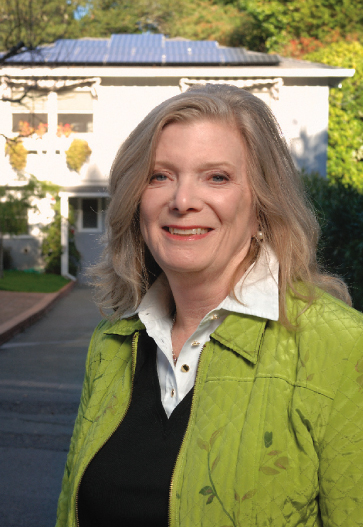Green Offsets A 3-kilowatt system offsets 6,261 pounds (or 3.13 tons) of carbon dioxide each year (the CO2 normally created by traditional fossil-fuel power plants) and is equal to 323 gallons of gasoline or 6.6 barrels of oil. It would take over 7 acres of tropical rain forest to absorb this much CO2. * info from SPG Solar
Thinking of going solar? Now is the time. For those who have missed the coverage on Lisa Max (pictured at left) and Go Solar Marin, here’s the scoop: it all started with an effort to get a lower price for solar in Max’s San Rafael neighborhood by pooling residents’ collective buying power. Somewhere along the way their quest grew to a countywide discount and forming Go Solar Marin. In addition to price, they were concerned with how well a company was run, how it dealt with its customers and, most important, how well it could service a large influx of new business. “Out of ten finalists, we selected Novato-based SPG Solar,” Max says, “because it best fulfilled Go Solar Marin’s mission, but as time has gone on, almost all of the companies have stepped up to match or outcompete SPG Solar’s offer of $7.94 a kilowatt.” The industry average is $9 a kilowatt for installing a system.
“The biggest reason to go solar now, besides the Go Solar Marin discount, is the state and federal rebates are not going to get any better,” says Max. “In fact, the longer you wait, the less you get back.” In January 2007, the state set up the $3.3 billion California Solar Initiative, which doles out rebates to homeowners who install solar power. “A typical home would use a 3-kilowatt system, and the current rebate is $2.20 per watt, which translates as approximately $6,600 back to the consumer plus another $2,000 federal investment tax credit that eligible homeowners can take on their next tax return,” says Amy Morgan of the California Energy Commission. “And as more people sign up, per-wattage discount decreases.” So use it or someone else will.
Max likens an investment in solar to a mortgage. “If you’re going to be paying $150 toward the electrical part of your bill,” she says, “you might as well be paying that toward a loan that will eventually be paid off.”
For instance, her friends had the first installation in the Go Solar Marin program. Their typical two-story, four-bedroom house occupied by two adults burns through about 10,000 kilowatt hours a year. Their initial proposals for a 2.165-kilowatt system came in at about $20,101 (not including the California state rebate of $4,391).This system is estimated to bring electrical usage down from higher tiers to the basic rate and reduce the average monthly electrical cost from about $150 a month to $50 a month—an annual saving of $1,200. A larger but more costly system could bring the monthly tab to zero.
After Go Solar Marin’s prices went into effect, the group signed up for solar at $17,172. After deduction of the state rebate (which most vendors will do up front, applying for the rebate themselves) the cost was $12,780. Then there is a $2,000 federal tax credit for solar systems, which brings the cost to $10,780. With anticipated rises in electrical costs, it is estimated that this solar setup will pay for itself in six to eight years.
Of course, some homeowners are put off by the aesthetics — or, better said, the lack of aesthetics — of a solar array on the rooftop. If only those gorgeous slate roof tiles could act as photovoltaic sensors, most owners could justify the cost in a heartbeat. While not invisible, today’s home solar setups are state-of-the- art. “Marin consumers have access to the latest technologies that are widely used around the world,” says Ted Walsh, solar advocate and sales manager at SPG Solar. “While the tiles are becoming more and more efficient at absorbing sunlight and converting it to energy, the actual size of the systems has not changed that much in the past five or 10 years.”
What if you have a small roof or tenuous sun exposure? “Even if you were to add a few panels,” says Walsh, “it would make a difference in your PG&E bill.” He points out that electricity is charged in tiers, as with a cell phone bill, discouraging excessive use by charging more as usage increases. Most homes in Marin, packed with a few computers, a couple fridges and a pool or hot tub, can easily run at the third tier without anyone turning a light on. If some energy usage is diverted to solar, the remaining electrical usage is charged at the lowest tiers — making a huge different in the actual bill.
For more information on Go Solar Marin, go to spgsolar.com. Max, a self- described math wonk, is also happy to help anyone interested in going over the numbers; she can be reached at [email protected].
So, why go solar?
The California Energy Commission offers a few reasons.
✹ A photovoltaic system (PV) reduces, or can completely eliminate, the amount of electricity you have to purchase from your utility or electric service provider.
✹ A PV system can save you money on your electricity bill and act as a hedge against future price increases.
✹ The electricity generated by your PV system is clean, renewable and reliable.
✹ You help your community by reducing the electricity demand, and you provide additional electricity for the grid when you generate more than you use during the day, when this demand is highest.
Solar Providers
Cooperative Community Energy
877.228.8700, ccenergy.com
Green Light Solar
415.381.2400
Marin Solar
415.456.2800, marinsolar.com
SPG Solar
415.883.7657, spgsolar.com
Sun First
415.458.5870, sunfirstsolar.com
Suntrek Industries
800.292.7648, suntreksolar.com
Solarcraft
415.382.7717, solarcraft.com
REC Solar
888.657.6527, recsolar.com

Mimi Towle has been the editor of Marin Magazine for over a decade. She lived with her family in Sycamore Park and Strawberry and thoroughly enjoyed raising two daughters in the mayhem of Marin’s youth sports; soccer, swim, volleyball, ballet, hip hop, gymnastics and many many hours spent at Miwok Stables. Her community involvements include volunteering at her daughter’s schools, coaching soccer and volleyball (glorified snack mom), being on the board of both Richardson Bay Audubon Center. Currently residing on a floating home in Sausalito, she enjoys all water activity, including learning how to steer a 6-person canoe for the Tamalpais Outrigger Canoe Club. Born and raised in Hawaii, her fondness for the islands has on occasion made its way into the pages of the magazine.


